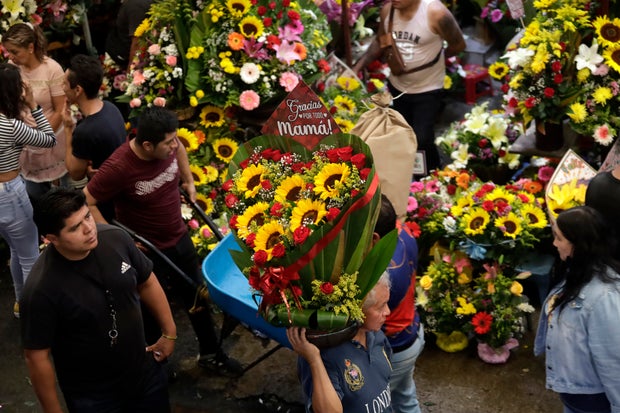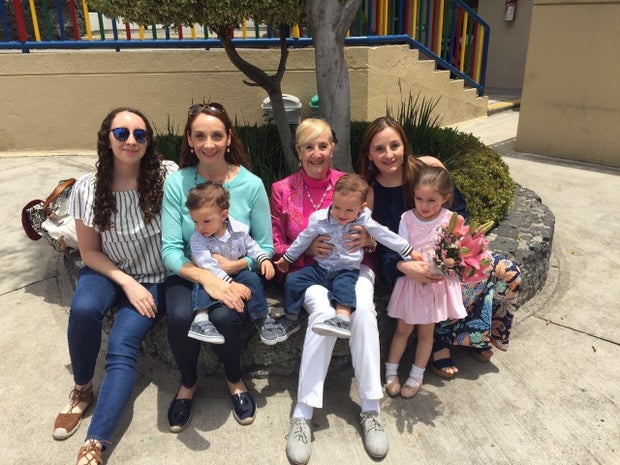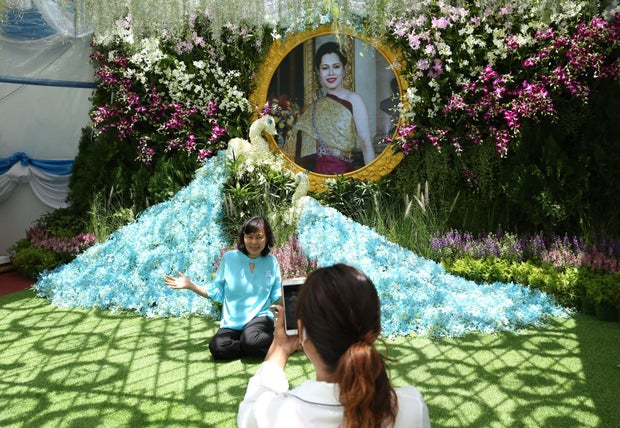CBS News
Mother’s Day traditions differ across the world — see how other families celebrate

It wouldn’t be Mother’s Day in the United States without the classic traditions Americans know best: large bouquets of roses and carnations, homemade cards, special outings, and accolades for moms near and far.
When the holiday was first started in 1907 by Anna Jarvis to honor mothers, the day’s event was at a Methodist church in West Virginia, where white carnations were reportedly distributed to those in attendance. President Woodrow Wilson in 1914 declared the second Sunday of May a national holiday.
Jarvis fiercely advocated for a day dedicated to mothers and then famously regretted how commercialized it became. In the years since, the holiday has become even more commercialized, with consumers spending a record $33.5 billion.
Over the years, other countries have adopted Mother’s Day, each offering its own unique take — some perhaps closer to the celebrations Jarvis envisioned Some countries celebrate on different dates, and others in May. Mexico celebrates on May 10, Thailand on August 12, Peru the second Sunday of May, and France typically the last Sunday in May, while the United Kingdom celebrates on the last Sunday of Lent, which varies each year.
There’s everything from mariachi serenades to visits to the local church to traditional meals made to honor the family matriarch. No matter how the festivities may look, the intention is the same: to share an appreciation for the women at the center of the family.
Here’s a sampling of some of the Mother’s Day traditions in other places around the globe.
Mexico
Día de Las Madres is celebrated each year on May 10, and festivities do not disappoint. Mexicans usually have the day off, so when the holiday falls on a weekday, they’re able to stay home and spend the day with their mom.
“The mother here is a very important figure,” Lola Barba, a mother of two who grew up in Mexico City, told CBS News. “The country stops when it’s Mother’s Day here.”
Luis Barron / Eyepix Group/Future Publishing via Getty Images
The week leading up to Mother’s Day, elementary schools organize festivals with dances, plays, and songs. Moms are invited to watch and enjoy the treats, said Barba. Families typically gather on the day for large meals with traditional menu items including mole, pozole, and enchiladas, while others opt to take their moms out to a local restaurant. But nothing beats the tradition of hiring mariachi bands or trios to serenade moms — sometimes early enough in the morning to wake them up!
Mexican Mother’s Day came about around the same time as the U.S. holiday, just over a century ago. Mexico later erected a monument to mothers called the Monumento a la Madre.
While she’s now based in Los Angeles., Barba still tends to celebrate Mother’s Day on the 10th. “I usually celebrate on the day, and sometimes I even celebrate twice!” she said.
Courtesy Lola Barba
Peru
Peruvians mark Mother’s Day, known as “Feliz Dia Mama,” by getting the whole household together, whether at a restaurant, or a relative’s house.
“In my family, we usually get together around lunchtime at someone’s house and spend the next several hours together, enjoying each other’s company and strengthening our family ties,” Laura Gonzales, 77, a mom from Lima, Peru told CBS News.
Families are also known to congregate at cemeteries to pay respect to deceased mothers, aunts, and grandmothers – particularly those who live in the provinces outside of the capital of Lima, said Gonzales. Many bring food, drinks, and flowers to lay down on the graves. Vendors have caught on and now sell flowers, balloons, and signs outside the cemeteries. What might seem like a somber tradition is actually regarded as a joyful celebration among Peruvian families.
Gonzales said that in the past, children would typically wear a red rose if their mother was alive, or a white one if they had passed. The tradition has faded over time, but red roses are still one of the most popular flower choices for mothers.
United Kingdom
In the U.K., Mother’s Day goes by a different name: “Mothering Sunday,” which honors the connection to the church in addition to mothers. During the Middle Ages, people who had moved away would come back each year on the fourth Sunday of Lent to visit their “Mother” church — typically where they were baptized. This was an opportunity to reconnect after long periods spent apart. Today, Mothering Sunday is still celebrated on the last Sunday of Lent, the date of which varies each year.
Richard Baker /In Pictures via Getty Images
The holiday’s connection to religion is less obvious nowadays, said Susan Morgan, a 65-year-old mom of three who lives in Suffolk, England. As a little girl, she recalls visiting family for afternoon tea and bringing them flowers and a homemade card.
“It felt like an important day to me, slightly religious, and about going with my mum to show respect to her mother and her mother’s mother,” Morgan told CBS News.
Thailand
In Thailand, Mother’s Day is a holiday that the entire country joins in on — it’s a public holiday and people are given the day off. Originally celebrated on April 15, the holiday was moved to August 12 in 1976 to coincide with the birthday of Queen Sirikit, a member of the Thai royal family.
Wang Guoan/China News Service via Getty Images
With double the reason to celebrate, there’s plenty of fanfare. Leading up to the 12th, buildings across the country are adorned with images of the queen, along with colorful flags, flowers, and lights. In Bangkok, the capital of Thailand, fireworks can be seen lighting up the sky during an annual ceremony for the queen.
Children offer their moms white jasmine flowers, which are in high demand in and around the holiday. “It is not just a holiday; it is the day that we appreciate mothers and motherhood and reflect how grateful we are,” said Ploy Khunisorn, who lived in Thailand for 22 years but is currently living in Boston.
Last year, the U.S. Embassy in Thailand extended warm wishes to the queen and all Thai mothers.
France
Celebrations look different depending on the family, but in France, it’s typical to offer moms small gifts and flower bouquets, like the famed Lily of the Valley.
Mother’s Day typically takes place on the last Sunday of May.
Spending quality time with loved ones is also an important part of how the French mark the day, Anne-Sophie Bellemin, a French mother of two who lives in the town of Novalaise, told CBS News
Bellemin said her husband has historically gone to le marché, the market, the morning of Mother’s Day to buy a colorful bouquet replete with roses, daisies and other flowers. “It was a tradition for the kids to give me the bouquet my husband had bought,” she said.
CBS News
How to watch the Minnesota Vikings vs. Chicago Bears NFL game today: Livestream options, more

Getty Images
The Minnesota Vikings will take on the Chicago Bears today. The Vikings are currently 8-2, an impressive run so far this season, and will be looking to add a fourth win to their current streak after last Sunday’s 23-13 win against the Tennessee Titans. The Bears, on the other hand, are entering this game on the heels of a four-game losing streak after a tough 20-19 loss against the Green Bay Packers last Sunday.
Here’s how and when you can watch the Vikings vs. Bears game today, whether or not you have cable.
How and when to watch the Minnesota Vikings vs. Chicago Bears
The Vikings vs. Bears game will be played on Sunday, November 24, 2024 at 1:00 p.m. ET (11:00 a.m. PT). The game will air on Fox and stream on Fubo and the platforms featured below.
How and when to watch the Minnesota Vikings vs. Chicago Bears game without cable
You can watch this week’s NFL game on Fox via several streaming services. All you need is an internet connection and one of the top options outlined below.
Fubo offers you an easy, user-friendly way to watch NFL games on CBS, Fox, NBC, ABC, ESPN, and NFL Network, plus NCAA football channels. The Pro tier includes 200+ channels and unlimited DVR, while the Elite with Sports Plus tier adds NFL RedZone and 4K resolution. New subscribers get a seven-day free trial and all plans allow streaming on up to 10 screens simultaneously.
You can watch today’s game with a subscription to Sling’s Orange + Blue tier, which includes ESPN, ABC, NBC, and Fox. The plan offers 46 channels with local NFL games, nationally broadcast games and 50 hours of DVR storage. For complete NFL coverage, add Paramount+ to get CBS games, or upgrade with the Sports Extra add-on for additional sports channels like Golf Channel, NBA TV and NFL RedZone.
Watching NFL games, including Fox broadcasts, is simple with Hulu + Live TV, which includes 90 channels, unlimited DVR storage, and access to NFL preseason games, live regular season games and studio shows. The service includes ESPN+ and Disney+ in the subscription.
Want to watch today’s game live on your smartphone? If so, NFL+ streaming service is the solution you’re looking for. It lets you watch NFL Network and out-of-market games on mobile devices, with an upgrade option to NFL+ Premium that includes NFL RedZone for watching up to eight games simultaneously. Note that NFL+ only works on phones and tablets, not TVs.
CBS News
How to watch the Detroit Lions vs. Indianapolis Colts NFL game today: Livestream options, more

Nic Antaya/Getty Images
The Detroit Lions will face off against the Indianapolis Colts today. The Lions enter this game as top contenders with a near-perfect record of 9-1 so far this season. The Colts, who are 5-6 this season, could have a tough game on their hands against the Lions but will be looking to rack up another win after prevailing over the New York Jets in a tight game last Sunday.
Here’s how and when you can watch the Colts vs. Lions game today, whether or not you have cable.
Here’s how and when to watch the Detroit Lions vs. Indianapolis Colts
The Lions vs. Colts game will be played on Sunday, November 24, 2024 at 1:00 p.m. ET (11:00 a.m. PT). The game will air on Fox and stream on Fubo and the platforms featured below.
How and when to watch the Detroit Lions vs. Indianapolis Colts game without cable
You can watch this week’s NFL game on Fox via several streaming services. All you need is an internet connection and one of the top options outlined below.
Experience NFL action like never before with Fubo’s comprehensive sports streaming platform. From Sunday showdowns to primetime matchups, catch every NFL game across major networks including CBS, Fox, NBC, ABC, ESPN and NFL Network. Choose the Pro package to unlock 200+ channels and limitless DVR storage, or elevate your game-day experience with the Elite with Sports Plus package, featuring NFL RedZone’s commercial-free scoring highlights and stunning 4K quality.
Test drive the service with a no-commitment seven-day free trial, and share the excitement with family and friends — Fubo supports simultaneous streaming on up to 10 devices, so everyone can watch their favorite teams.
You can watch today’s game with a subscription to Sling’s Orange + Blue tier, which includes ESPN, ABC, NBC, and Fox. The plan offers 46 channels with local NFL games, nationally broadcast games, and 50 hours of DVR storage. For complete NFL coverage, add Paramount+ to get CBS games, or upgrade with the Sports Extra add-on for additional sports channels like Golf Channel, NBA TV and NFL RedZone.
Watching NFL games, including Fox broadcasts, is simple with Hulu + Live TV, which includes 90 channels, unlimited DVR storage, and access to NFL preseason games, live regular season games and studio shows. The service includes ESPN+ and Disney+ in the subscription.
Want to watch today’s game live on your smartphone? If so, NFL+ streaming service is the solution you’re looking for. It lets you watch NFL Network and out-of-market games on mobile devices, with an upgrade option to NFL+ Premium that includes NFL RedZone for watching up to eight games simultaneously. Note that NFL+ only works on phones and tablets, not TVs.
CBS News
How to watch the New England Patriots vs. Miami Dolphins NFL game today: Livestream options, more

Getty Images
The New England Patriots will face off against the Miami Dolphins in a game today at the Hard Rock Stadium in Miami. The Patriots have had an uneven season so far, coming into the game with a record of 3-8, including a 28-22 loss to the Los Angeles Rams on November 17. The Dolphins, however, haven’t fared much better this season as they enter the game with a record of 4-6, although they are coming off two wins in a row, the latest against the Las Vegas Raiders last weekend.
Keep reading to find out how and when to watch the New England Patriots vs. Miami Dolphins game today, even without cable.
CBS, Paramount+ and CBS Essentials are all subsidiaries of Paramount Global.
How and when to watch the New England Patriots vs. Miami Dolphins game today
The New England Patriots vs. Miami Dolphins game will be played on Sunday, November 24, 2024 at 1:00 p.m. ET (10:00 a.m. PT). The football game will be shown on CBS and streamed on Paramount+ and the platforms noted below.
How and when to watch the New England Patriots vs. Miami Dolphins game without cable
While CBS is available with many basic cable packages, you’ll have other viewing options, too for the Patriots-Dolphins game. Just understand that the below streaming options will require the use of an internet provider:
Paramount+: Watch CBS-aired NFL games without cable
With Paramount+ you’ll have multiple viewing options to choose from. You can catch NFL games on the Paramount+ Essential tier for just $7.99 each month or you can watch college football with a Paramount+ with Showtime subscription for $12.99 monthly. In addition to live streams of NFL games airing on CBS, you’ll get to watch additional live sporting events including NCAA college football, PGA Tour golf, soccer and more.
Get started with Paramount+ here today.
Amazon Prime Video: Add Paramount+ to your existing subscription
Already have an Amazon Prime Video account? Simply add Paramount+ to your current subscription to watch all the CBS-aired NFL games in addition to Paramount+ originals. The same prices from above apply, depending on which tier you choose. Not sure which is best for you? Don’t worry. Both options come with a free seven-day trial that can help you decide.
Watch the Patriots-Dolphins game on Amazon Prime Video.
Fubo: Watch the Patriots-Dolphins game for free
Looking for an inexpensive way to watch football? Fubo could be the best way to do so. The live TV streamer is currently offering a seven-day free trial and $30 off of your first month’s subscription. Once subscribed, you’ll gain access to all of their live sporting events immediately. And there will be a lot to choose from. Not only does Fubo come with access to NFL games airing on your local CBS channel, it also includes Fox Sunday NFC games, “Sunday Night Football” on NBC, “Monday Night Football” on ABC and ESPN and all of the games that air on the NFL Network. So don’t wait.
Get started with Fubo online now.














